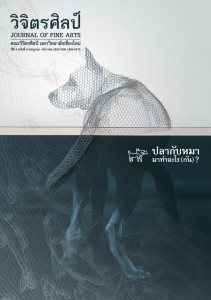แนวคิดมหาปุริสลักขณะ พระพุทธปฏิมา ศิลปะไทลื้อ เมืองน่าน
Main Article Content
Abstract
จากการวิเคราะห์องค์ประกอบของมหาปุริสลักขณะและอนุพยัญชนะซึ่งมีปรากฏในองค์พระพุทธปฏิมาศิลปะไทลื้อ เมืองน่าน พบว่าลักษณะจากแนวคิดมหาบุรุษที่สามารถมองเห็นได้จากภายนอกพระวรกายเท่านั้น ที่มีปรากฏในส่วนประกอบของรูปทรงพระพุทธปฏิมา โดยสามารถจำแนกออกได้เป็นมหาปุริสลักขณะ 16 ประการ และอนุพยัญชนะ 36 ประการส่วนลักษณะบางประการที่ไม่ปรากฏในองค์พระพุทธปฏิมา เนื่องมาจากไม่สามารถมองเห็นได้อย่างชัดเจน และมีข้อจำกัดในการแสดงออกด้วยรูปแบบงานประติมากรรม อาทิ กลิ่น เสียง และการเคลื่อนไหวในอิริยาบถต่างๆ ตลอดจนลักษณะอันเป็นนามธรรม ไม่สามารถถ่ายทอดแนวคิดผ่านรูปทรงพระพุทธรูปที่เป็นวัตถุได้
นอกจากนี้ การวิเคราะห์รูปแบบศิลปกรรมของพระพุทธปฏิมา ศิลปะไทลื้อ เมืองน่าน พบว่า รูปแบบ กรรมวิธี และวัสดุที่ใช้ในการสร้างพระพุทธรูปทุกองค์ สามารถแสดงออกได้แตกต่างกันตามความรู้และจินตนาการของปฏิมากรผู้สร้างสรรค์ในแต่ละชุมชน รวมทั้งได้ปรับปรุงรูปแบบที่ได้รับมาให้สอดคล้องกับสุนทรียภาพของตนเอง และพัฒนาจนเกิดลักษณะเฉพาะของท้องถิ่นได้ในที่สุด มีลักษณะเป็นงานศิลปะพื้นถิ่น โดยถ่ายทอดจินตนาการด้วยรูปทรงที่เรียบง่าย ตรงไปตรงมา และเป็นธรรมชาติ สะท้อนให้เห็นถึงความงาม สุนทรียภาพ และภูมิปัญญาของชาวพุทธ อันมีบ่อเกิดมาจากจิตใจที่เปี่ยมล้นด้วยความศรัทธาต่อพระพุทธศาสนา ตลอดจนแสดงถึงคุณค่าและความสำคัญ ในฐานะเป็นมรดกทางวัฒนธรรมของชาติ
The Concept of Marks of the Great Man Buddha Image in Tai Lue Art in Nan Province.
This research aims to study the concept of marks of the Great man Buddha image presented in the Tai Lue art in Nan province so as to analyze the artistic from of the Buddha image with regard to meanings and signs in relation to Buddhist’s belief, culture, and thinking methods which still influence life styles of local people, society, and Lan Na culture.
The findings revealed that the concept of marks or the major characteristics is the normative criteria for constructing and forming the shape of a Buddha image which were described through Buddhist literatures and the general appearance of a Buddha image. The major characteristics of the Buddha refer to the signs of the Great man enumerated in the extant manuscripts, existing before the Buddhist Era, which described that the person who are ideally regarded as the ‘Great man’ are a king who possesses the virtues and the Lord Buddha who no longer has defilement. Being regarded as the Great man results from attaining Buddhahood of Bodhisattvas in former lives, and the result of merit is presented in the 32 signs of the Great man and secondary elements, called the 80 minor characteristics, the causal process and its implication. This is a sermon on consequence of one’s action where the major signs are the physical evidence.
A study into the elements of both the major and the minor characteristics represented through the Buddha images in Tai Lue art in Nan province showed that the characteristics, derived from the concept of the Great man, seen only from the physical body form the Buddha image shape, divided into 16 major characteristics and 36 minor characteristics.
The other characteristics not evident in a Buddha image are due largely to unclear visibility and the constraints on representation of sculpture works, such as scent, sound, and movement in several postures, as well as subjective characteristics which the concept cannot be transferred through such a material image. In addition, an analysis of the artistic form of the Buddha images in Tai Lue art in Nan province also found that the methods and materials used for constructing every single Buddha image can represent differences depending upon and with regard to knowledge and imagination of a sculptor in each community. The derived form has, afterwards, been developed so as to be in conforming to individual aesthetics. And eventually become a unique form, referred to as Folk Art, for particular community. Such the artistic imagination, transferred in a simple, straightforward, and natural shape, reflects exquisite aesthetics and local wisdom of Buddhists which stem from the mind immeasurably full of faith in Buddhism, and presents value and prominence as national cultural heritage.


